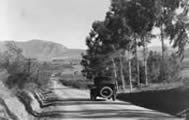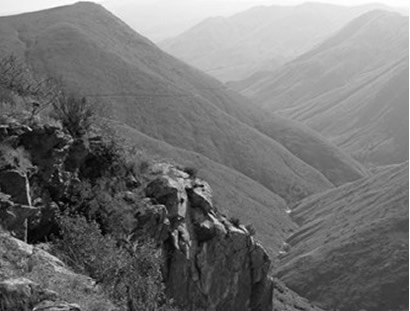|
Viejas Valley. Source unknown.
by Albert Simonson
Looming above Alpine is the sacred Viejas Mountain, called “Song-Dance” in the Kumeyaay language. Pilgrimages were made to its summit to honor the Sun (In’ya), the great Ruler of All Things. They watched In’ya rise exactly over Buckman Mountain at winter solstice, marked the exact alignment with stone and sang in the great dance circle at the summit. This area was already mapped by Presidio Ensign Velasquez in 1783. A chain of meadows between Harbison Canyon and Viejas Reservation formed a natural highway, the “Camino de Secuan,” for driving presidio horse-herds to Cuyamaca pasturage.
By the 1830’s, Kumeyaay and other local tribes were in open revolt. After losing horses and ammunition to the Indians in 1837, leatherjacket soldiers approached Viejas only with greatest caution. In 1846, the mission and the Osuna family acted to close the frontier to stop marauding Indians. The elder Osuna had been mission administrator and first mayor of San Diego, heading the first democratic town government in California. Thus was established the Rancho Valle de las Viejas y Mesa del Arroz, stretching from Sycuan to Viejas reservations. In 1848 they sold the cattle rancho to “Cockney” Bill Williams and “El Santo” Aguirre.
Cockney Bill, a salty sailor turned mountain man, allied himself with mountain and desert Indians and together they were able to put Viejas to the plow. Aguirre, an elegant Basque trader and ship owner, co-founded what is now downtown San Diego. To supply San Diego and Fort Yuma with grain, trains of ox-drawn carts, driven by Indians, began to rumble through the grass mesa (Mesa del Arroz) toward Secuan. More grain was produced here than anywhere else in the county, and the Viejas ox-cart road was a lifeline to the army. This was a time of tricultural harmony, with men and women of Viejas working together in laying out downtown San Diego, creation of roads, manufacture of ox-carts and providing Fort Yuma wagon trains.
In 1857 the first transcontinental mail stages passed through Viejas and Cockney Bill ran the vital Viejas Stop, herding mules and feeding passengers for the San Antonio and San Diego mail line. The gigantic rancho enterprise was tragically ended by drought, plague, civil war, lawsuits and death. Viejas fell silent and remained vacant for years.
In the 1870’s, George Washington Webb established the “Alpine Ranch” and the “San Diego-Julian Toll Road Company” to grade a road along the old “Camino de Secuan.” At the newly-formed “Alpine School District,” the beguiling Miss Emma Everhart set up school in a two-story schoolhouse, and became involved in a notorious killing. One young French sheepherder lay dead, and Webb’s young son was charged with murder. Miss Everhart remained single and went on to success as a fashionable downtown milliner with several stores.
Nick and Lucy Overmier planted Zinfandel Vines and a village nucleus in 1872. Their house was just behind the post office. They called it “Cove Ranch” but everyone else still called it “Valle de las Viejas.” In 1884, a tuberculosis epidemic brought new people to the pure mountain air of a renamed “Alpine,” and the old name was relegated to the eastern valley where a rougher breed of settlers practiced mayhem and murder to settle old quarrels.
Beautiful houses built by Benjamin Arnold around the turn of the century, together with surviving 1880’s homesteads, reflect Alpine’s role as a refuge from urban congestion. And so it remains today.
|




